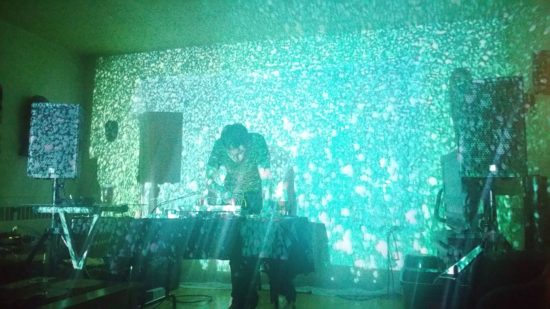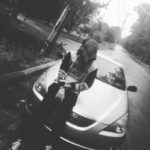In the year 1996, I visited my brother in Edmonton, Alberta. He was studying percussion in music school.
One evening my brother, our dad and I went for some coffee at a little spot called “The Sugar Bowl”
(café/bar/music venue). Something happened to me that night that I will never forget. I saw a real DJ
casually spinning vinyl. In the spirit of 1990s music culture, he was blending Bjork, Portishead, various
Chili Hop and Ninja Tune tracks. He was wearing wallabee shoes and his short, almost buzzed hair was
dyed in a leopard-skin pattern; he appeared fascinating and alternative, and perhaps a little mysterious.
The closest I ever came to something like this was while living in Regina a year or so earlier at the Earls’
Restaurant (original location) when I spied this guy who had massive blond dreadlocks and was wearing
a black Nirvana t-shirt that featured a yellow happy face with Xs for eyes. He was sitting outside on the
deck area with a very specific “like whatever man” vibe while coolly sipping a Corona beer with lime.
That was a special moment too, but now this real live performing DJ stood at the frontier of my
understanding of what was possible in music, culture, and style, and I liked it!
Fast forward to my early 20’s: I am attending the University of Regina, studying art and something of
this nature happens again. I learned through word-of- mouth that this electronic musician named Ryan
Hill was capable of using computer software, drum machines and analog equipment to make
interesting, conceptual electronic music. I was astounded that he lived and performed here – in a
relatively isolated small prairie city. As the years passed and I attended numerous rave parties powered
by ecstasy and featuring a variety of DJs who mix a flow of electronic music, using synthesizers,
subwoofers et al, it became apparent to me that my quiet, conservative and middle-of- nowhere prairie
city can offer more than meets the eye.
Ryan Hill, who is known sonically as Guidewire had always existed as some kind of phantom genius to me. This was primarily due to the fact that I wasn’t really“ on the internet” at full capacity yet. I mean, maybe I had MySpace just a little? But certainly this was pre-Bandcamp, pre-SoundCloud, and people still predominantly purchased and promoted CDs.

In abstract visual language, Guidewire and the mystique around Ryan Hill always translated through my
perception as a contorting, shifting shiny shape, capable of molecular mutation and sonic convulsions.
Once in a while, I would observe him walking down the hall at school wearing a green army jacket and
loose blue jeans. However, it wasn’t until I saw him perform a random but colourful live set at Regina’s
German Club, circa 2009, that his music became real to me. In more recent years, with the advent of
independent music accessibility on the web, I have had the privilege of digging into Guidewire’s
impressive and vast catalogue of self-released EPs, LPs, and conceptual audio projects, all of which
confirm my suspicion of some years – Guidewire is a fractal gemstone synthesizing geometric
components in a nuanced, sometimes treacly, complex, and considered sonic pursuit. I recently
conducted an interview with the artist himself on everything sonic, historically inspirational, visual, and
to play the tricky game of his self-definition.
Tell me about young Ryan Hill – Guidewire in the making. What brought you to the world of sound
and expression? (And did you really love the Hackers soundtrack?”)
I really didn’t get into music much until the Hackers soundtrack. I never actually owned a copy though.
It was kind of a gateway into a bunch of interesting music that was being made at the time. It was super
cheesy, but it helped me start researching what was happening out in the world. I absolutely loved
Halcyon + On + On by Orbital. Their album In Sides was probably my first proper electronic album.
Beck’s Odelay was also a huge entry point for sample/collage style music.
We didn’t have cable at our house and didn’t listen to much radio. I always felt like all the other kids in
school knew what was going on in pop music and I was a little cut off. In 1995, it seemed like most
people got computers and hopped on the internet. That really launched my ability to follow my
interests. One of my Dad’s co-workers helped us figure how to plug our keyboard into our computer
using MIDI and all of a sudden, I was an electronic musician.
Though, really early on my Dad and Grandma played piano around the house. My Grandma played
music for local churches and such. From that I think I ended up moving toward the piano impulsively.
My parents got me into piano lessons, which helped me along.
Ethereal, fractal, geometry, prolonged celebration, tectonic shifts, shape plethora …
These are word associations I developed while engaging with your music. Tell me your word
associations. Tell me how language, aesthetic and how the physical world fits (or does not fit) into
the Guidewire audio experience. Artists often consider their aesthetics and visual language. How do
you approach this aspect of artist identity?
Mangle, process, space, drift, morphology, anxious, macro/micro, lazy, dirt, aspirational, Crypto, moire,
integrate temporal anti-aliasing, multi-hyphenate, palimpsest …
I’m really conflicted about language and words. I like playing with words and I feel that I have a poetic
sensibility. Since I got really serious into music, I have always been against the leading power of words.
I didn’t know how lyrics force the listener to follow a certain frame of mind. Instrumental music feels
like a science where you explore your own mind and not someone else’s. Also, I hate naming music. A
track title always feels like some quick random word so I can save my file and then I’m stuck with it.
As far as my aesthetic is concerned, I feel like I’ve always just followed what I thought was interesting. I
have always hovered around being a graphic designer and visual artist of some kind, constantly playing
around with imagery in parallel to the music-making. I do have a face/tag that has always kind of been a
constant throughout everything. It’s a kind of music memory thing that has been burnt into my hands.
If you look carefully, you may find it in my regular haunts.
What are you hating the most about being an independent, electronic artist in 2017?
The value of music. Finding my audience. Over-abundance of music.
I listen to this podcast called “Art + Music + Technology” by Darwin Grosse:
He summed up this feeling that I think hits on something. He
brought up this idea of how streaming music presents this kind of infinite collection of music, and if you
aren’t listening to something new, you aren’t getting the most value out of the service. There was a
feeling of guilt when listening to something more than once. Ownership of physical copies supports re-
listening and streaming really doesn’t.
A robust rectangle or an understated parallelogram?
Undertangled robollelogram.
You have an impressive catalogue of varied projects. Tell me about the most fun you had making one and why it was fun.
Frozen Tones! It’s probably not the most pleasant to listen to, but this performance recording was done using dry ice, a wheelchair ramp off a bus, and a variety of drum cymbals. The metal acts as some kind of heat sink that causes the dry ice to sublimate and vibrate and all kinds of crazy frequencies. I ran that through a computer to process it in a variety of ways. The room I performed in was ridiculously hot. I liked this interesting dynamic of these extreme temperatures.
The song “Edmonton Wedding” from your semi-recent “Fertility” EP – more on that, please. Process, thoughts, what was happening when it was made, and why it was made. It’s my favorite.
It’s one of my favourites as well. It was created surrounding a weekend when I went to a friend’s
wedding out near Edmonton. It was a crazy experience because the friends we were staying with had an
intense break-up and my wife and I were stuck in the middle. I was experimenting with live mic-ing at
the time. Normally most of my process is editing little musical structures with a mouse and maybe
recording a jam and cutting it up. So, I had that normal process for the main structure and then
recording one take of me playing piano in my dining room. Main part was before the wedding and piano
was after. Maybe the intensity of the weekend helped me to play a little heavier. Having the piano part
helped tie everything together and became the main thing.
https://guidewire.bandcamp.com/album/fertility-ep
What can we expect from Guidewire in 2017/2018/2019?
Taking myself more seriously as an artist. Gathering up all my large collection of recordings and trying to
figure out how to put the best stuff out. I’ve calculated it to be somewhere around 1,300 project files.
It would be nice to get more external help to sift through it all. There are a number of amazing pieces in
there and an equal part horrible. Would love to get more performances happening, and maybe get an
artist residency to help finish up and sort through all of this stuff.
Keep up with Guidewire here:









